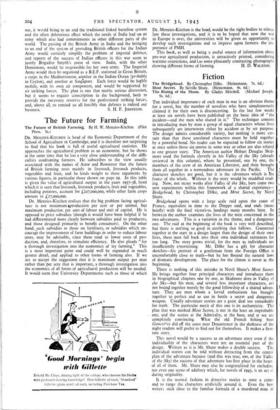The Future for Farming
The Future of British Farming. By H. W. Menzies-Kitchen. (Pilot Press. 5s.) DR. MENZIES-KITCHEN is head of the Economic Department of the School of Agriculture in Cambridge, and it is therefore not surprising to find that his book is full of useful agricultural statistics. He approaches the agricultural problem as an economist, but he shows at the same time that he has a very close understanding of the diffi- culties confronting farmers. He subscribes to the view usually associated with the names of Astor and Rowntree that the future of British farming rests mainly in livestock, livestock products, vegetables and fruit, and he lends weight to these arguments by various figures, in particular those shown on page 29. In this table is given the value of agricultural output in the years 1937-38, front which it is seen that livestock, livestock products, fruit and vegetables, including potatoes, account for £227,000,000, while other farm crops amount to £27,000,000.
Dr. Menzies-Kitchen realises that the big problem facing agricul- ture is not maximum {production per acre or per animal, but maximum production per unit of labour and unit of capital. He is opposed to price subsidies (though it would have been helpful if he had differentiated more clearly between subsidies paid to producers, and those designed primarily to benefit consumers). On the other hand, such subsidies as those on fertilisers, or subsidies which en- courage the improvement of farm buildings in order to reduce labour costs, may be advisable, since these tend to lower costs of pro- duction, and, therefore, to stimulate efficiency. He also pleads " for a thorough investigation into the economics of ley farming." This is a most important point and could well be expanded in much greater dttail, and applied to other forms of farming also. If we are to accept the suggestion that it is maximum output per man rather than per acre that is important, a thorough investigation into the economics of all forms of agricultural production will be needed. It would seem that University Departments such as those of which
Dr. Menzies-Kitchen is the head, would be the right bodies to stimu- late these investigations, and it is to be hoped that now the war in Europe is over, the universities will be given an opportunity to develop such investigations and to impress upon farmers the- im- portance of PMH.
This book, as well as being a useful source of information about pre-war agricultural production, is attractively printed, considering wartime restrictions, and has some pleasantly contrasting photographs showing different forms of farming. H. D. WALSTON.


























 Previous page
Previous page